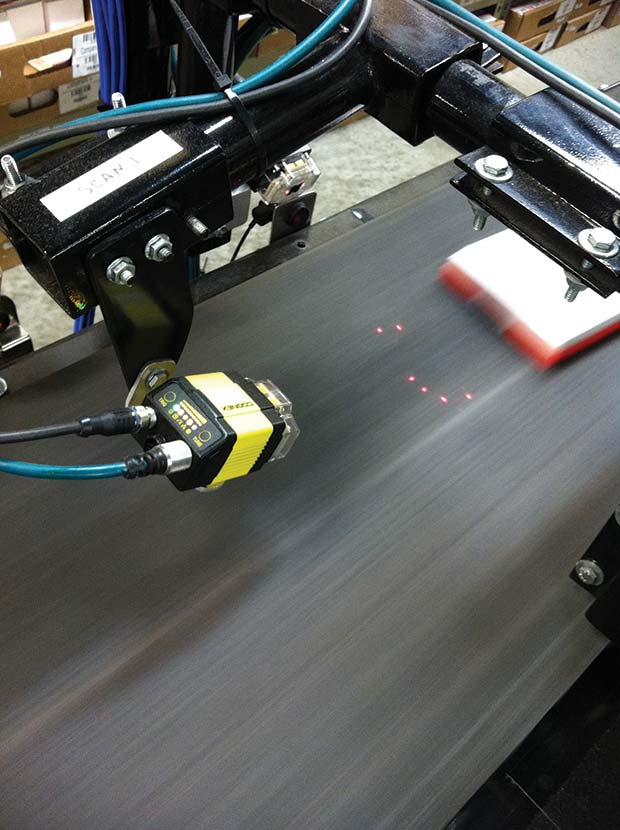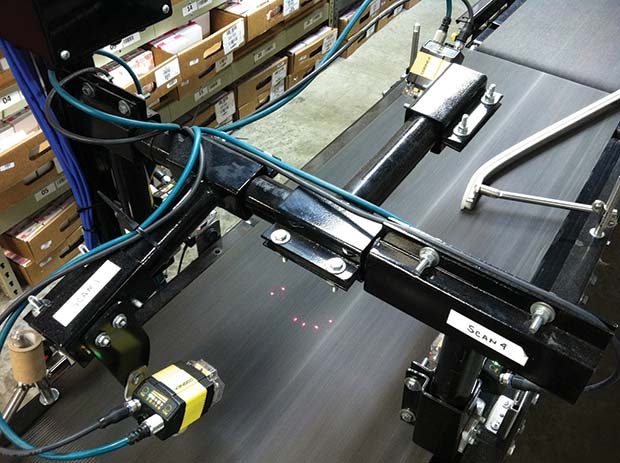In the warehouse of a major direct sales jewellery company, pickers place jewellery boxes on two conveyors that transport them to packing stations. A 1-D barcode on each box is read by ID readers located above the conveyor and based on this identification, each box is diverted to the correct packing station. The laser scanners in place were designed to read A & B quality barcodes, which the jewellery company had planned to begin putting on its boxes. However, the company was unable to get the A & B quality barcodes from their manufacturer and the scanners were only able to read 96.5% of the barcodes, requiring two fulltime people to handle the read failures. Cornerstone Automation, the systems integrator involved in the project, collected all of the boxes that could not be read in a day and asked Cognex, a leading developer of vision based ID readers, if they could offer a solution. Cognex’s DataMan 302L vision-based reader read every one of the read failures. The new ID readers have increased read rates to above 99.9% and saved 75 hours per week in read failure handling.
 Barcode reading challenge
Barcode reading challenge
The jewellery boxes are approx. 3 inches wide by 3 inches deep by 1.5 inches tall. A 1-D barcode is placed by the manufacturer on the front end of the lid of the box so it faces forward although the quality of these barcodes varies significantly. When a wave of orders is run, the dispensers automatically eject the boxes needed to fill the wave onto the conveyor. No attempt is made to orient the barcodes in a specific direction.
This automated system is highly efficient but it depends heavily on the ability of the barcode reader to read the barcode on nearly every box travelling down each line at a rate of about one per second. After the codes are read, a labelling machine prints a larger 3 inch by 3 inch label and applies it to the bottom of the jewellery box. In the past, a scanning tunnel was positioned upstream from the packing stations that used four laser scanners each pointing at one of the four sides of the boxes to read the smaller labels.
Despite some advantages, lasers have difficulty reading codes in a degraded condition, at varying angles and in different positions. Because they see only a single scan line at a time, laser scanners have a very limited ability to read codes that are in any way different from an ideal image.
The laser scanners used in the past were able to read the majority of barcodes but the approximately 3.5% of codes that they were not capable of reading, constituted over 2,000 boxes over a typical day. These codes needed to be manually read and a label needed to printed and applied by hand to each box.
Move to vision-based technology
The jewellery company asked Cornerstone Automation to improve the read rates on the poor quality barcodes on the line. Since the line was originally installed, substantial improvements in vision-based ID reading technology have provided new cost effective options in addressing this challenge.
“We brought Cognex in and asked if they could help with the read failures,” said Michael Doke, Partner with Cornerstone Automation. “Cognex asked us to collect all of the barcodes that the laser scanners could not read in a day. Cognex brought one of their vision-based scanners in and set it up and it read every single one of those barcodes.” Cognex recommended the DataMan 302L fixed-mount barcode reader for this application. The DataMan 302L has a resolution of 1280×1024 pixels and liquid lens variable autofocus technology that is ideal for applications that require a large depth of field. The liquid lens keeps the code in focus even when the distance from the camera to the code is changing, which happens because the barcodes can be located anywhere on the wheels.
Implementing the solution
Four Cognex 302L ID readers were set up in four different directions at a distance of 12 to 16 inches from the box at a 20 degree angle to the conveyor belt. The four ID readers were configured using group triggering so that all four readers acquire an image simultaneously and then combine their individual read results to form a composite result. Whenever any reader detects a code, the master reader generates and transmits a read result to an industrial PC, simplifying the task of collecting and processing read results from multiple readers.

The new readers provide a 99.9+% read rate. This dramatic improvement in read rates has made it possible for the two people previously assigned to manually read the labels, to be moved to more productive tasks. The end result is that the jewellery direct seller has eliminated a major headache and significantly reduced its distribution costs.
Cognex




Comments are closed.